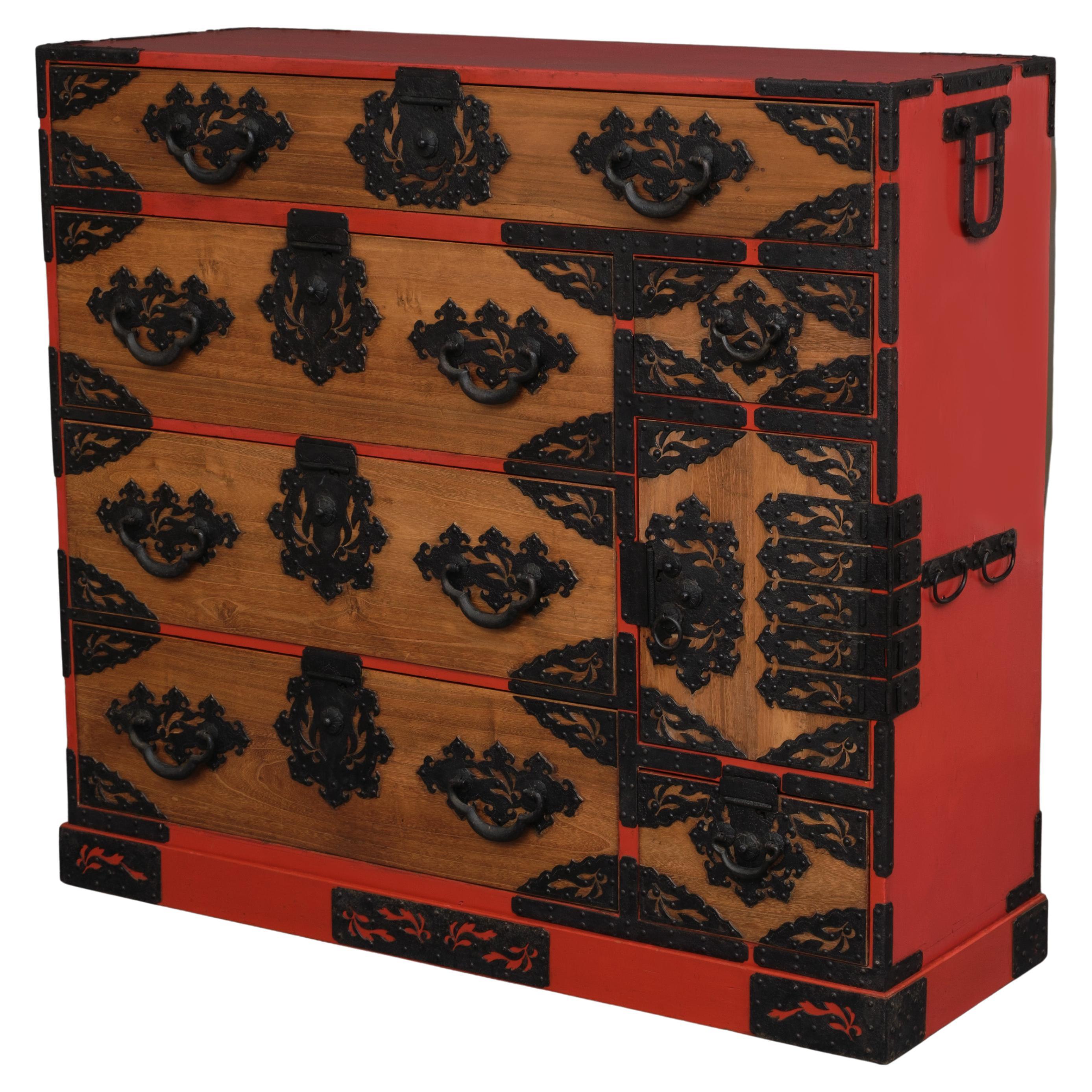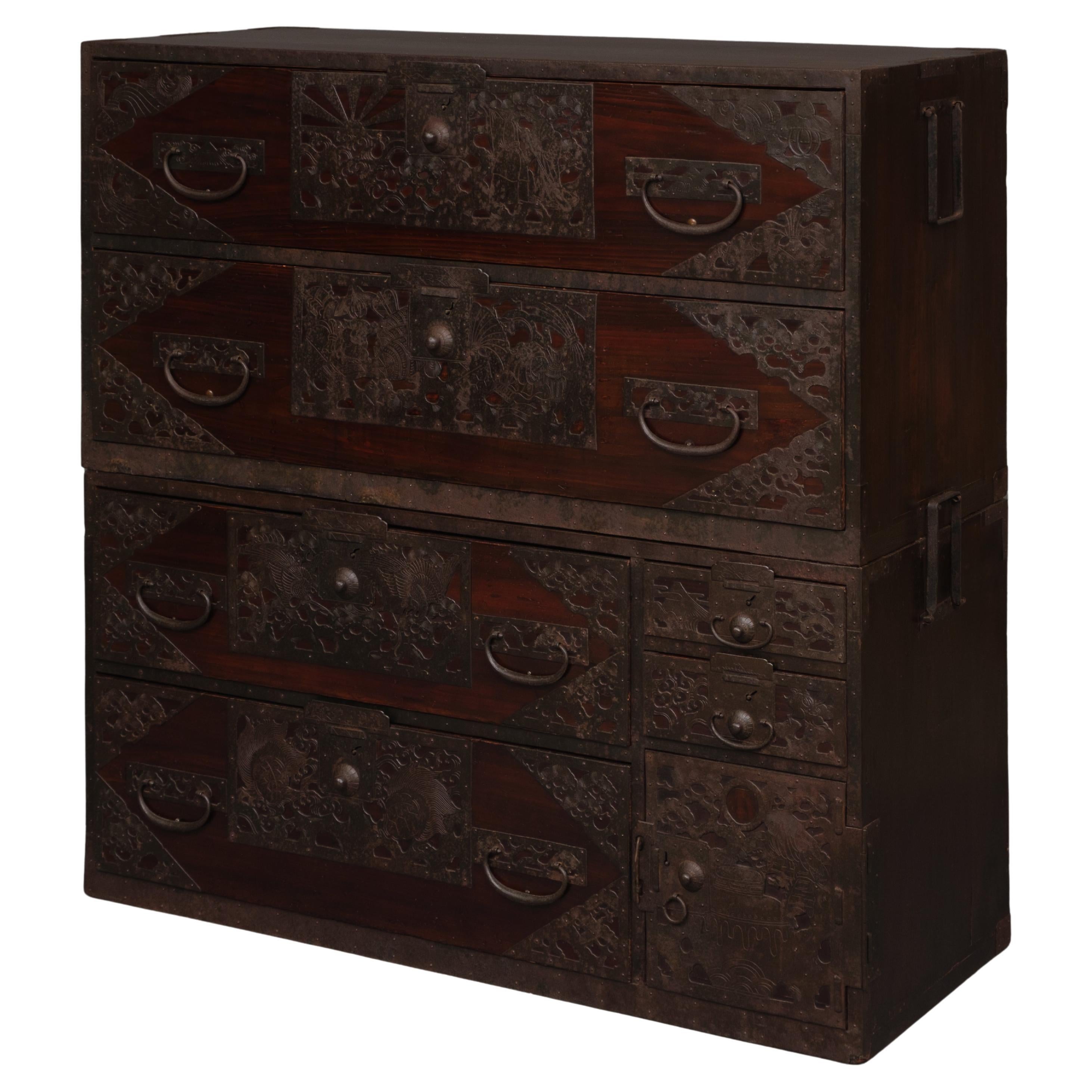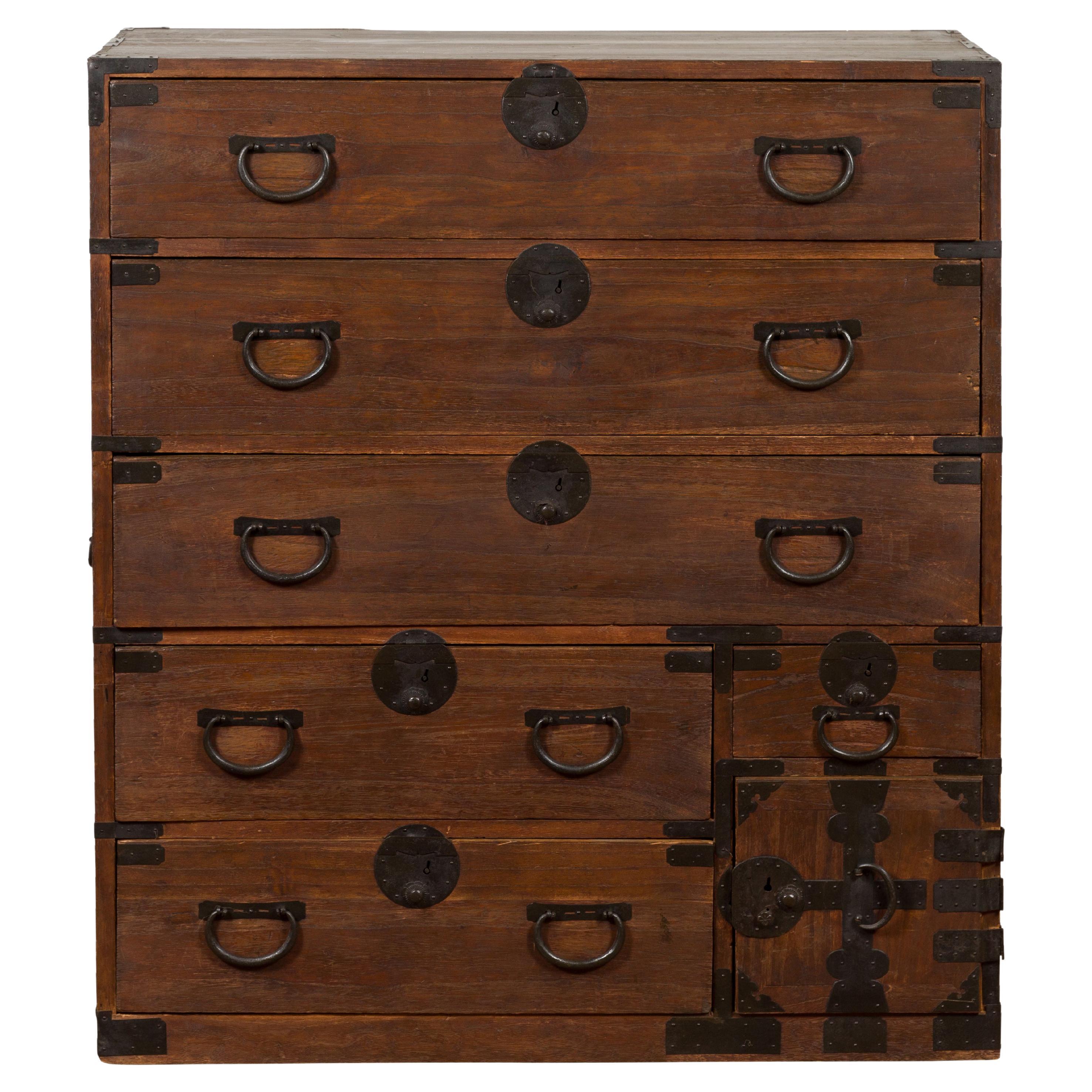Items Similar to Japanese Kantô kannon’biraki ishô’dansu 衣装箪笥 (chest of drawers with doors)
Want more images or videos?
Request additional images or videos from the seller
1 of 14
Japanese Kantô kannon’biraki ishô’dansu 衣装箪笥 (chest of drawers with doors)
About the Item
Remarkable wooden Kantô kannon’biraki ishô’dansu (cabinet of drawers with hinged doors) in two sections equipped with striking iron hardware. Fully restored, cleaned and waxed.
The drawer fronts are made from indigenous kiri (paulownia) wood, and the frame from Japanese hinoki cypress wood. Varnished in a sought after warm brown hue, a colour that we like to call ‘golden oak’.
The upper part constructed with a pair of hinged doors heavily clad with protective hardware with reticulated motifs. The large circular lock plate decorated with a crest (mon) depicting three leaves surrounded by a shield. Equipped with two domed knobs shaped like chrysanthemum (kiku) flowers. The doors open to two large drawers.
The lower part with two drawers and a hinged door, with to two more small drawers behind.
They are equipped with sturdy iron ‘warabite’-shaped bail handles with matching elongated escutcheons, and large circular lock plates.
The sides with ‘pole carrying’-handles for easy transport and ‘locking’ the upper section into place.
This type of cabinet originates from the Kantô region, the region around the capital city Edo (which is now known as Tôkyô).
The kannon’biraki’dansu, also known as ryô’biraki’dansu, was destined to store women's clothing and was developed in Edo. The story says it was specially thought of for Edo’s Yoshiwara pleasure quarters to decorate the courtesans’ rooms.
They are also said to be bridal cabinets for storing bridal kimono’s. These big, opulent kimonos fit perfectly in the upper section's drawers because they are a little higher than those in other traditional Japanese clothing cabinets.
When shipped we will add a certificate of authenticity.
Kindly get in touch with us so that we can offer you an appropriate shipping quotation.
- Dimensions:Height: 43.31 in (110 cm)Width: 35.71 in (90.7 cm)Depth: 16.5 in (41.9 cm)
- Materials and Techniques:
- Place of Origin:
- Period:
- Date of Manufacture:Meiji period (1868-1912)
- Condition:Repaired: Fully restored, cleaned and waxed. Please see the photos for a condition reference. The locks are inoperable. A fastened key in the hinged door functions as its grip. Wear consistent with age and use. The cabinet is in a very good restored condition with some minimal traces of age. The drawers run very smoothly. The cabinet is deep so there is a lot of volume for easy storage.
- Seller Location:Amsterdam, NL
- Reference Number:
About the Seller
5.0
Vetted Seller
These experienced sellers undergo a comprehensive evaluation by our team of in-house experts.
Established in 1996
1stDibs seller since 2022
16 sales on 1stDibs
Typical response time: 10 hours
- ShippingRetrieving quote...Ships From: Zwanenburg, Netherlands
- Return PolicyA return for this item may be initiated within 14 days of delivery.
More From This SellerView All
- Rare, Japanese Kyûshû 九州 ishô’dansu 衣装箪笥 (chest of drawers)Located in Amsterdam, NLRare and richly adorned wooden Kyûshû ishô'dansu (cabinet of drawers) in a single section, on a plinth. Fully restored, cleaned and waxed. The drawer faces are made of indigenous k...Category
Antique Late 19th Century Japanese Furniture
MaterialsIron
- Japanese Sado ishô’dansu 衣装箪笥 (cabinet of drawers) with extensive iron hardwareLocated in Amsterdam, NLHigh-quality Sado wooden ishô’dansu (cabinet of drawers) in two sections. Heavily clad with decorative iron hardware featuring rich designs, and a little secret. Fully restored, cleaned and waxed. The drawer faces made from solid indigenous cedar (sugi) wood. Finished with a deep dark red lacquer with a great patina. The upper part is configured with two large drawers, and the bottom with four drawers of different sizes and a hinged door. Opening to three more small drawers. Behind these drawers lies a concealed storage compartment. As illustrated in the photos, the small drawer on the right is slightly shorter. Behind it is the hidden storage space, accessible only by removing the left drawer since the opening extends all the way to the back on that side. Each lock plate of the cabinet has its own refined reticulated design, showcasing; a pair of elder figures tending a pine tree (matsu) when the sun is rising on the horizon; two of the Seven Gods of Fortune...Category
Antique Late 19th Century Japanese Furniture
MaterialsIron
- Japanese Sado ishô dansu 衣装箪笥 (cabinet of drawers) with elaborate hardwareLocated in Amsterdam, NLExceptional, rare and completely restored wooden Sado ishô dansu (cabinet of drawers) with elaborately decorated open work iron hardware, in two sections. Fully restored, cleaned and waxed. The exterior is made of hinoki cypress wood. Only slightly varnished, giving it a tad warmer colour. This soft underground lets the refined hardware stand out even more. The upper part consists of two large drawers. The lower part with two drawers of different size and a hinged door. The interior behind the door with three small drawers. All the drawers are very deep and have a lot of volume, for easy storage. They run very smoothly as well. The cabinet has extensively decorated hardware. The corner pieces of the drawers with stylized pine trees. The large decorative lock plates each with their own unique design of different auspicious animals; a peacock, a phoenix, a crane and a minogame. The hinged door decorated with different attributes of the Seven Gods of Fortune...Category
Antique Late 19th Century Japanese Furniture
MaterialsIron
- Japanese round wooden cha'dansu 茶箪笥 (tea cabinet)Located in Amsterdam, NLUnique and beautiful round wooden chadansu 茶箪笥 (tea cabinet) made of a hollow tree trunk. Placed on a lovely organically formed three root. The exterior of the display cabinet has a...Category
Early 20th Century Japanese Furniture
MaterialsWood
- Rare set of 2 Japanese suits-of-armour, complete with 2 matching folding screensLocated in Amsterdam, NLImportant unique set of two suits-of-armour (yoroi), complete with two high six-panel screens, that belong together as is indicated by the used family crests (mon). Two crests are used, both belonging to the Nakagawa family of Oka Castle, Ôita prefecture on Kyûshû. They are: – the Nakagawa-kurusu, a circle depicting a Celtic-like cross through a ring. The cross was originally a Christian symbol but after the ban on Christianity in Japan the use of a hidden cross in family crests could continue. – the Nakagawa-kashiwa, two leaves of the Japanese Emperor Oak turned to each other (dakikashiwa mon). The remarkable aspect of this ensemble is the presence of matching crests on both the yoroi and the accompanying folding screens. The kurusu and kashiwa crests adorning the yoroi are elegantly replicated on the screens, providing compelling evidence that these pieces form a harmonious and unified set. This exceptional cohesion between the armour and screens further enhances their artistic and historical value. After the warlord Toyotomi Hideyoshi (1537-1598) had interfered in the battle between the Lord of Bungo Province Ôtomo Yoshi-mune (1558-1605) and the Shimazu of Hyûga Province, he split the Bungo Province in a number of small fiefs and transferred in 1594 Nakagawa Hideshige (1570-1612) from Miki Castle in the Harima Fief to Oka Castle in Kyûshû. The Nakagawa family stayed in possession of Oka Castle till the abolishment of the military use of castles in 1873. In 1884 the Nakagawa family received the title of Count (a title in use till the abolishment of aristocracy in 1947). After the Nakagawa’s left, the castle and the building soon dilapidated and is now known as Oka Castle Ruins. The castle is located in Taketa Village part of Taketa Town in Ôita Province on Kyûshû. > Set of two tall byôbu (folding screens), painted with large red jinmaku (camp enclosure curtain) on a gold leaf ground. The curtains show both crests of the Nakagawa family: one screen depicts two Nakagawa-kurusu crests next to a Nakagawa-kashi crest in the middle, and the other shows the symbols the other way round. Dimensions: Total width 148.66 in/377.6 cm (2 x 25.35 in/64.4 cm, 4 x 24.48 in/62.2 cm); Height 72.63 in/184.5 cm. Period: Japan – Late Edo period (First half 19th century), and maybe even older. > Yoroi with Nakagawa-kashiwa crest: A Japanese black lacquered suit-of-armour (yoroi) completely laced with orange cords (kuro’urushinuri hi’ito odoshi nimai’dô’maru). A thirty-two plate suji’bachi kabuto (helmet with raised ridges) with in front a maedate (fore crest) -with traces of gilding- in the shape of flames, resembling a mythical flaming bird flying down. The fukikaeshi (face guards) and the mabizashi (visor) have the Nakagawa-kashiwa crest in gold maki-e lacquer. Five curved ‘itazane’-plate neck guards (shikoro) laced with orange cords. Together with an ‘angry man...Category
Antique 18th Century Japanese Antiquities
MaterialsGold Leaf, Iron, Metal
- Pair of Japanese cast iron chôshi 銚子 (sake kettles) with lacquered lidsLocated in Amsterdam, NLPair of enticing cast iron chôshi (sake kettles) with a detailed lacquered lid, raised by three low feet. Its rotund body with a subtle embossed design of stylized symbols, like myth...Category
Antique Early 19th Century Japanese Antiquities
MaterialsSilver, Iron
You May Also Like
- Japanese Tansu, chest-on-chest (isho kasane-dansu), YonezawaLocated in Point Richmond, CAJapanese chest-on-chest for clothing storage (isho kasane-dansu) from Yonezawa, constructed of hinoki (Chaemaecyparis obtusa) and keyaki (Zelkova serrata) drawer fronts, traditional ...Category
Antique Late 19th Century Japanese Meiji Furniture
MaterialsWood
- Japanese Taishō Tansu Chest in Isho-Dansu Style with Six Drawers and SafeLocated in Yonkers, NYA Japanese Taisho period single section tansu clothing chest from the early 20th century in Isho-dansu style, with six drawers, safe, carrying handles and dark patina. Created in Japan during the Taisho period in the early years of the 20th century, this wooden Isho-dansu clothing chest features a linear silhouette perfectly complimented by a dark finish. The organized façade showcases six drawers (three large ones followed by two medium size and a smaller one), each fitted with iron hardware made of C-scroll handles and a central lock. The lower right section presents the safe, which opens to reveal additional drawers. Tansus were portable chests...Category
Early 20th Century Japanese Taisho Commodes and Chests of Drawers
MaterialsIron
- Japanese Meiji Zebra Wood Tansu Chest in Isho-Dansu Style with Five DrawersLocated in Yonkers, NYA Japanese Meiji period single section tansu clothing chest from the late 19th century in Isho-dansu style, with zebra wood, five drawers and carrying handles. Created in Japan during the Meiji period in the later years of the 19th century, this wooden Isho-dansu clothing chest features a linear silhouette perfectly complimented by a dark zebra wood grain. The organized façade showcases five drawers (three large ones followed by two smaller ones at the bottom), each fitted with iron hardware made of C-scroll handles and a central lock. Tansus were portable chests...Category
Antique Late 19th Century Japanese Meiji Commodes and Chests of Drawers
MaterialsIron
- Japanese Meiji Period Late 19th Century Isho-Dansu Chest with Iron HardwareLocated in Yonkers, NYAn antique Japanese Meiji period two-part tansu chest from the late 19th century with dark red lacquer, iron hardware, small safe and carrying handles. Created in Japan during the Meiji period (1868-1912), this wooden chest called an Isho-Dansu chest is a fine example of Japan's traditional mobile cabinetry. Tansus were portable chests...Category
Antique Late 19th Century Japanese Meiji Commodes and Chests of Drawers
MaterialsIron
- Japanese Meiji Period 19th Century Isho Dansu Clothing Chest with Brown LacquerLocated in Yonkers, NYA Japanese Meiji period Isho Dansu clothing chest from the 19th century, with six drawers, iron hardware and professionally refreshed brown lacquer. Created...Category
Antique 19th Century Japanese Meiji Commodes and Chests of Drawers
MaterialsIron
- Japanese 19th Century Keyaki Wood Isho Dansu Clothing Chest with Iron HardwareLocated in Yonkers, NYA Japanese 19th century keyaki wood Sendai clothing tansu (Isho-dansu) with four drawers and elaborate handcut iron hardware. Born during the 19th century in the Sendai prefecture, t...Category
Antique 19th Century Japanese Commodes and Chests of Drawers
MaterialsWood
Recently Viewed
View AllMore Ways To Browse
Small Kimono
Asian Cabinet Handles
Japanese Step Chest
Exterior Asian Doors
Asian Hand Carved Cabinet
Used Teak Furniture Victoria
Crack Is Whack
Asian Lacquer Cabinets China Cabinet
Lacor Furniture
Italian 1940 Chair
Numbers On Furniture
Set Of Sconces Mid Century
Set Three Chairs
2009 Chair
Rare Vintage Carpet
Around The Tree Furniture
Copper Handle
Rare Vintage Rug





